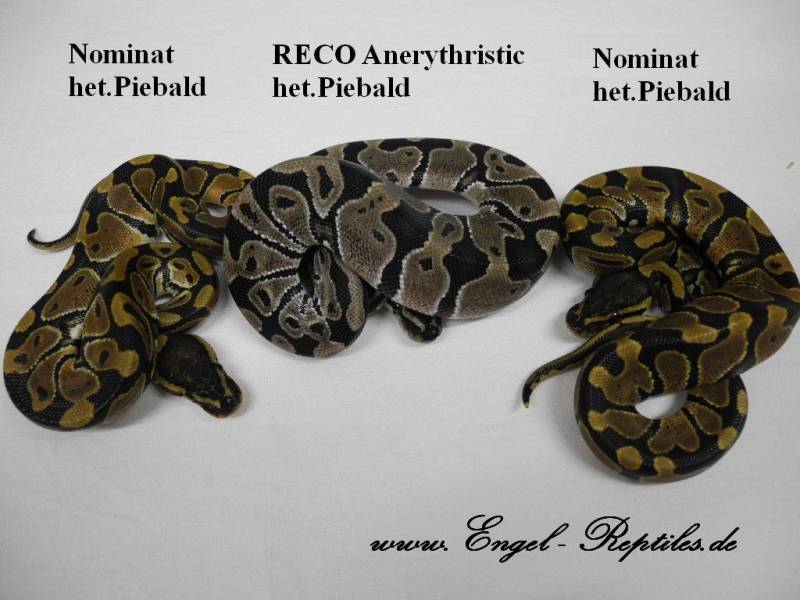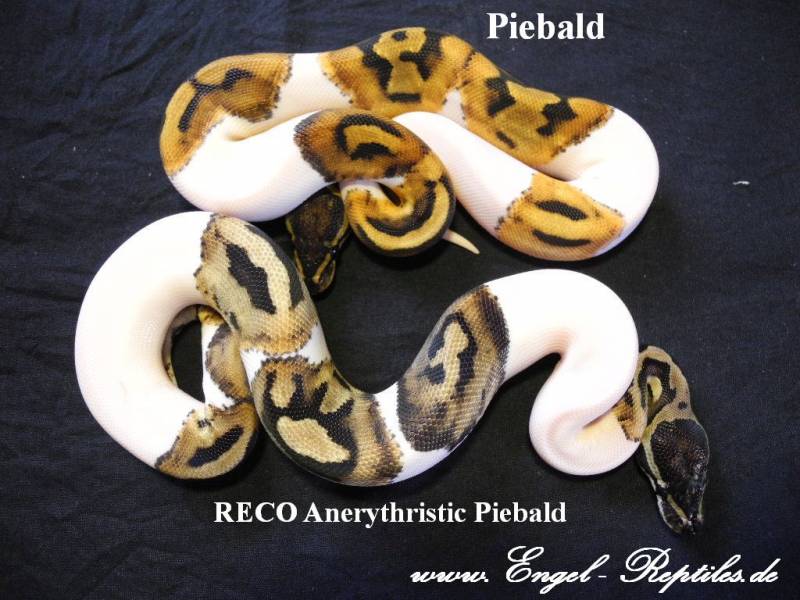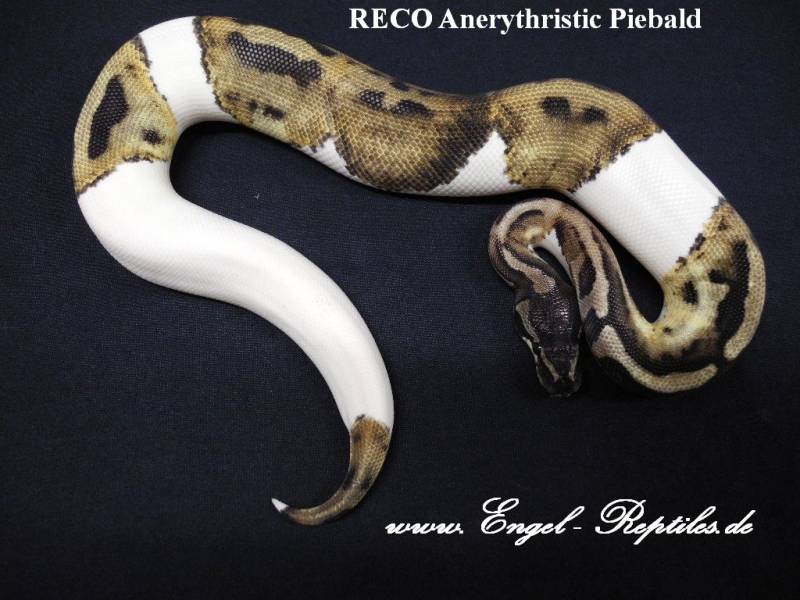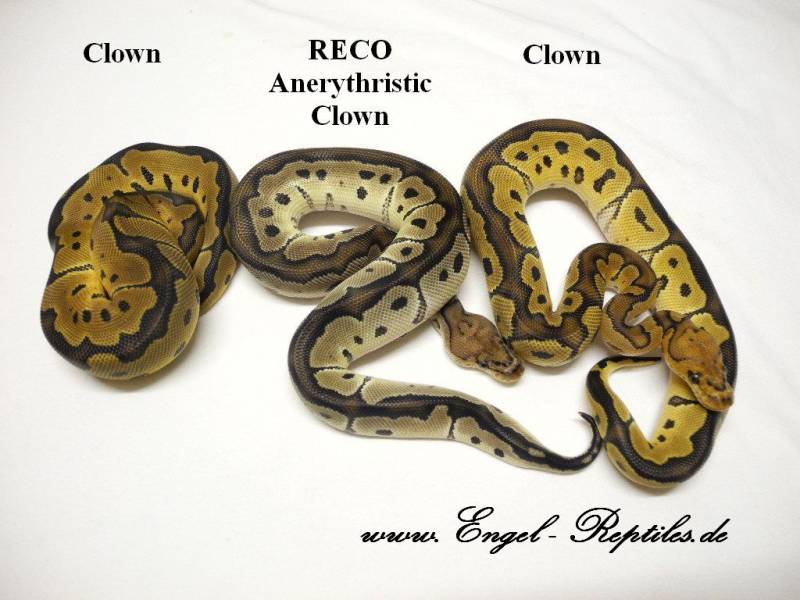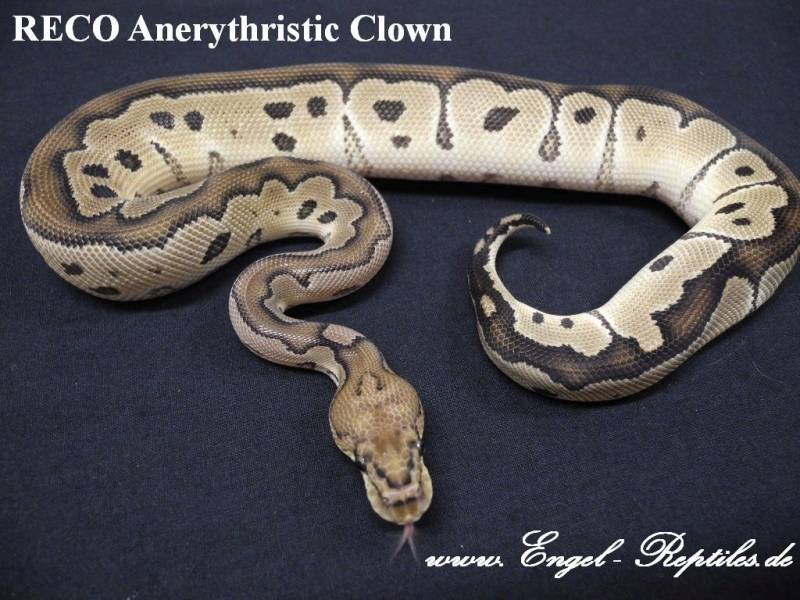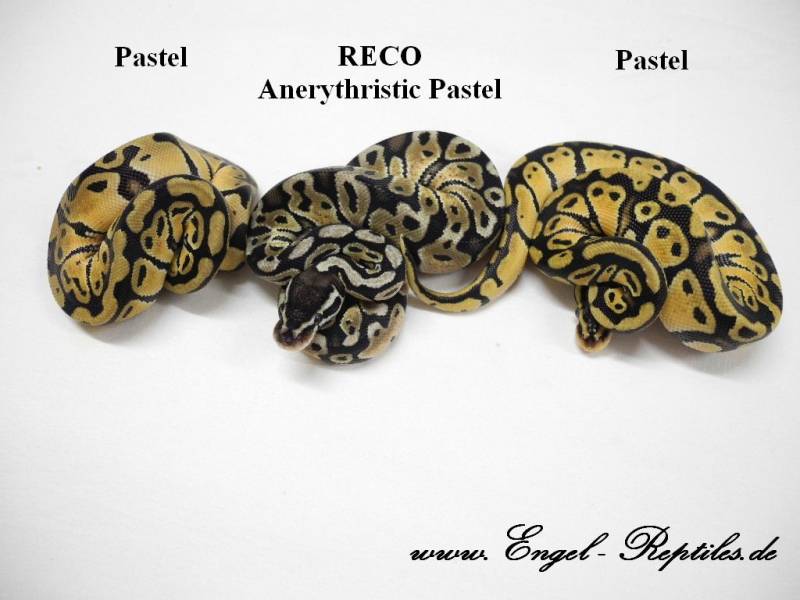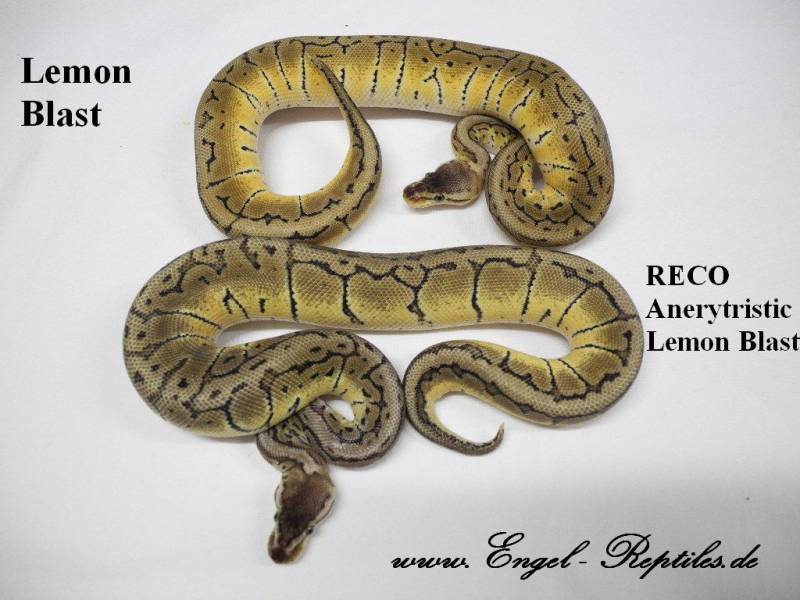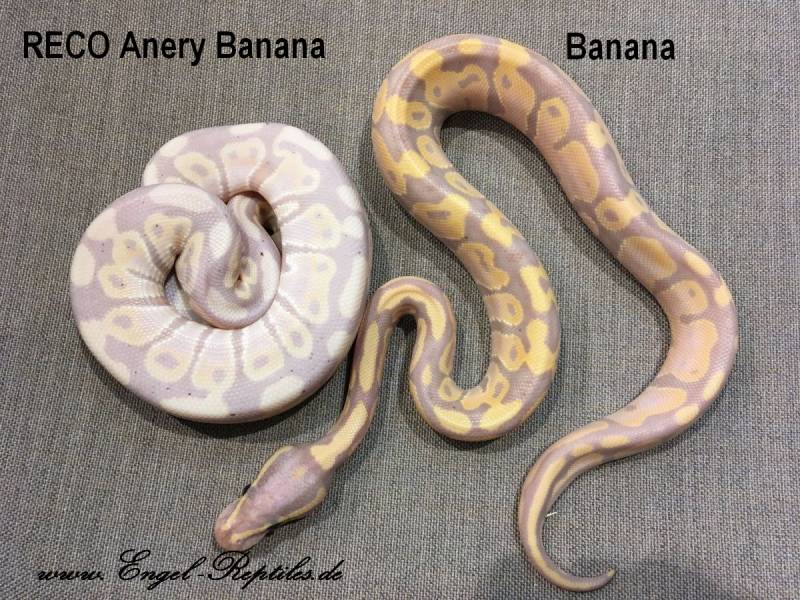RECO Anery
English Version below
Anerythristic Piebald
Hallo!
heute möchte ich euch eine phantastische Story erzählen, die sich über 7 Jahre Köpiezucht hinzieht und die klassische Vererbungslehre völlig auf den Kopf stellt.
Es geht um ein Tier, welches wir im Nachhinein den Namen RECO Anerythristic gegeben haben. Es fing alles mit dem Kauf eines Weibchens an, welches wir als Axanthic gekauft haben und was auch wie ein Axanthic aussah.
Wie viele von euch, wollten wir damals auch einen Axanthic Piebald züchten. Die ersten Bilder von Markus & Jayne Ball Pythons von einem Lightening Pied haben uns sofort begeistert. Wie ihr alle wisst, ist es ein doppelt rezessives Tier, ein Projekt, welches man nicht innerhalb von 3-4 Jahren abschließen kann. Trotzdem, wir wollten es durchführen. Dazu war unser Einstieg dieses Axanthic Weibchen. Sobald sie zuchtreif war, haben wir sie in 2011 mit unserem Piebald Bock verpaart um doppel hets. zu bekommen. Erfreulicherweise hat sie auch 11 gesunde Eier gelegt. Alle waren vertil und nach 8 Wochen sind 11 schöne, gesunde Schlangen geschlüpft, jedoch war etwas seltsam. Es waren 4 Tiere dabei, die anders aussahen als der Rest. Wir konnten uns keinen Reim darauf machen. Sie sahen aus wie Axanthics.
Das konnte eigentlich nicht sein. Es dürften nur doppel hets. heraus kommen und keine anders gefärbten Tiere. Es stellte sich heraus, dass alle 4 sonderbaren Tiere Männchen waren und alle anderen normal gefärbten 7 Tiere Weibchen. Die einzige Erklärung, die ich hatte war, dass unser Männchen het. Axanthic sein muss und das die andersfarbigen Tiere alles Männchen sind, Zufall sein muss. Damit war die Sache für uns erst einmal erledigt. Als die Weibchen paarungsbereit waren, wurden sie mit den Männchen aus dem gleichen Wurf verpaart. Das Ergebnis deutete, wie nach der normalen Vererbungslehre berechnet, mit einer Chance von 1:8, auf einen Axanthic het. Pied hin. Wir bekamen auch wunderschöne Piebalds, die am Anfang auch wie Axanthics aussahen. Deshalb stand für uns fest, dass es Axanthics sein müssen. Erst mit der Zeit bekamen sie jedoch einen immer gelberen Farbton; daher konnten es keine Axanthics sein.
Sie enthielten schwarz und gelb, aber kein rot. Somit konnte es sich nur um Anerythristics handeln.Es kamen insgesamt 12,6% Anerythristic Piebalds heraus. Diese Quote bestätigt auch, dass es sich in der ersten Generation um Anerythristic het.Piebald Männchen handeln musste, da bei doppel hets nur 6,2 % Chance auf einen Anerythristic Pied besteht. An dem theoretischen Wert von 12.5 % (1:8) waren wir exakt dabei
Anerythristic Clown
Das nächste Projekt welches wir in Angriff nahmen, waren Anerythristic Clowns. Wir verpaarten unser Clown Männchen wieder mit dem Anerythristic Weibchen und bekamen ein Gelege von 14 Eiern, woraus 14 normal gefärbte doppel het. Weibchen schlüpften.
Ein dummer Zufall? 14 Weibchen und kein passendes doppel het. Männchen dabei (das ist auch eine Story, die ich später einmal aufgreifen werde. Dieses Clown Männchen zeugte bis dahin 60 Nachkommen mit verschiedenen Weibchen und alle 60 davon waren weibliche Tiere). Also im folgenden Jahr die gleiche Verpaarung, aber mit einem anderen Clown Männchen, da wir nicht wieder nur Weibchen haben wollten. Aus dieser Verpaarung bekamen wir 8 Eier, bei denen wieder 3 seltsam aussehende Tiere dabei waren. Es wiederholte sich das gleiche Spiel wie bei den Piebalds.
Es waren wieder 3 Anerythristic het. Clowns dabei und alles wieder Männchen. Die restlichen 5 Tiere waren normal gefärbte doppel het. Weibchen. Jetzt stand für uns fest, dass wir hier ein spezielles Vererbungsschema vor uns hatten, was es bis dato noch nicht gab. Im darauf folgenden Jahr 2014/2015 waren die ersten doppel het.Clown Weibchen schon geschlechtsreif, aber die Anerythristic het.Clown Männchen noch nicht und so wollten wir wenigstens mit diesen doppel het. Weibchen einfache Clowns züchten. Wir verpaarten Sie mit einem weiteren Clown Männchen, welches wir uns zwischenzeitlich zugelegt hatten. Wir bekamen 4 Gelege mit insgesamt 28 Eiern. Als sie geschlüpft sind, war es für uns keine große Überraschung, als 1 Anerythristic Clown und 5 Anerythristic het.Clown Männchen darunter waren.
Spätestens jetzt war das Vererbungsschema absolut klar. Da in diesen Würfen auch normalfarbene Männchen dabei waren, vererbt diese Linie das Anerythristic Gen in die männliche Linie codominant und in die weibliche rezessiv. Ein Vererbungsschema, was bis heute weltweit einmalig ist. Es gibt zwischenzeitlich schon viele von den Normen abweichende Vererbungsschematas wie z.B. die Male oder Female-Maker bei dem Bananas, die Super stripes oder unser female maker Clown aber solch eine Vererbung war noch nicht da. Da das Anerythristic Gen bei den weibchen Nachkommen rezessiv und auf die Männchen codominant vererbt wird, haben wir diese Tiere RECO Anerythristic getauft. Bei einem codominanten Tier müsste es eigentlich auch eine Super Form geben, die haben wir bis heute leider noch nicht bekommen, obwohl wir schon mehrere Verpaarungen doppel hets mit Anerythristic Piebald hatten.
Weitere Verpaarungen nach dem gleichen Schema:
RECO Anerythristic mit Lemon Blast. Es kamen wieder in der F1 Generation RECO Anery Pastel Männchen und RECO Anery Lemon Blast Männchen heraus.
Die Zukunft wird zeigen, welche fantastischen Morphen mit unserem RECO Anery noch gezüchtet werden. Noch können Sie einer der ersten Züchter sein, die das weitere Potential dieser Morphe ausloten kann. Möchten Sie eine dieser Morphen erwerben, bitte eine E-Mail an unsere Adresse ( kontakt@engel-reptiles.de )schreiben. Wir teilen Ihnen dann mit, welche Morphen noch verfügbar sind. Ich hoffe, dass Sie unsere RECO Anerythristic genau so toll finden wie wir und verbleiben
Mit besten Grüßen
Engel Reptiles
English Version
The RECO Anerythristic Story (
(New Anerythristic Morphs)
Anerythristic Piebald
Hi everybody!
I’m coming from 15 years of breeding Ball Python and today I want to tell you a fantastic story which turned the traditional genetic theory upside down completely.
It’s about an animal which we named RECO Anerythristic later on. It all started with the purchase of a snake, which we got as an Axanthic female and we believed it was one, but it did not. (see pic. below).
“Axanthic” ??? Piebald
As many of you, we also wanted to breed an Axanthic Piebald. The first photographs of Markus + Jayne Ball Pythons of a Lightening Pied immediately made us enthusiastic. As you all know, it is a double recessive animal, which means a project you can’t finish within 3-4 years. Still we wanted to try it. This is why we bought this “Axanthic” female. As soon as she became fertile we mated her in 2011 with our Piebald male to get double hets. Luckily, she laid 11 healthy eggs. They were all fertile and 8 weeks later we had 11 beautiful, healthy snakes, but there was something strange. 4 of them looked different than the others. We did not understand how this had happened. One of these 4 animals is in the picture below. This should not be possible. Only double Hets should have been the result and not “Axanthics”, this snakes look like. We found that all of those strange 4 animals were males and all of the others, the 7 normal colored ones, were females. The only explanation I had was, that our Pied male must be a het. Axanthic. So, we just accepted it.
Picture: RECO Aneryxthristic Het. Piebald and double Hets
When the females were ready to breed, we mated them with the males of the same clutch. The result would lead to an Axanthic Het. Pied, with a theoretical chance of 1:8. We really got beautiful Piebalds, but they were not Axanthic! They had a yellow colour. They had black and yellow, but no red. So they could not be Axanthic, it could only be an
Anerythristic.
Pictures: RECO Anerythristic Piebad
All in all, we got 12.6% Anerythristic Piebalds this time. This quota also confirms that in the F1 generation must have been Anerythristic het. Piebald males, because with double Hets chances are only 6.2% that you get an Anery Pied. So, we hit the theoretical quota of 12.5% (1:8) exactly.
Anerythristic Clown
The next project we were up to were Anerythristic Clowns. We mated our Clown male with the Anerythristic female and got a clutch of 14 eggs of which 14 were normally colored double het. females.
Pictures: RECO + Clown
Just a funny coincidence? 14 females and no matching double Het. male (this is a story I want to tell you another time. Until then, this Clown male had produced 60 baby snakes from mating different females and exactly 60 of them had turned out to be females). In the following year, we mated the purchased female with another Clown male as we did not want to get solely females again. From this mating, we got 8 eggs which again showed 3 strangely looking animals in the F1 generation. It was the same story as with the Piebalds. Again, there were 3 Anery het. Clowns and all of them males (see pic. below).
Picture RECO Anerythristic Het. Clown and double Hets
The other 5 animals were normally colored double Het. females. Now we were certain that we witnessed a special pattern of genetic inheritance which had not been there before.
In the following year 2014/2015, the first of the double Het. Clown females already were sexually mature, but the Anery het. Clown males not yet and so we wanted to breed some normal Clowns with these double Het. females at least. We mated them with another normal Clown male which we had bought in the meantime. We got 4 clutches of 28 eggs altogether. As soon as they had hatched, it was no surprise to us to see 1 Anerythristic Clown and 5 Anerythristic het. Clown males among them.
Picture: Normal Clowns + RECO Anerythristic Clown
So now, at the very latest, the pattern of genetic inheritance was absolutely clear. As in these litters there were also normally colored males, this line passes on the Anerythristic gene as codominant in the male line and as recessive in the female line. A pattern of genetic inheritance which has been unique in the world until today.
In the meantime, there are many patterns of genetic inheritance which deviate from the standard like the Male or Female-Maker with the Bananas, the Super stripes or our female maker Clown, but such an inheritance is completely new. As the Anerythristic gene is passed on recessively with the female offspring and
codominant with the male one, we called those animals RECO Anerythristic. Being a codominant animal, it should produce Supers as well but we did not manage to produce this until today, although we had had many mating periods Double Hets with Anerythristic Piebalds.
More matings following the same pattern:
RECO Anerythristic with Lemon Blast. We got in the F1 generation RECO Anery Pastels and RECO Anery Lemon Blast males. Here you see, that the morph das a lot of yellow, but no red.
Pictures: RECO Anerythristic Pastel and RECO Anerythristic Lemon Blast in the F1 Generation
I hope that you find our RECO Anerythristics as great as we do and so we send to all of you our
Best regards,
Engel Reptiles
(www.engel-reptiles.de)
Germany

